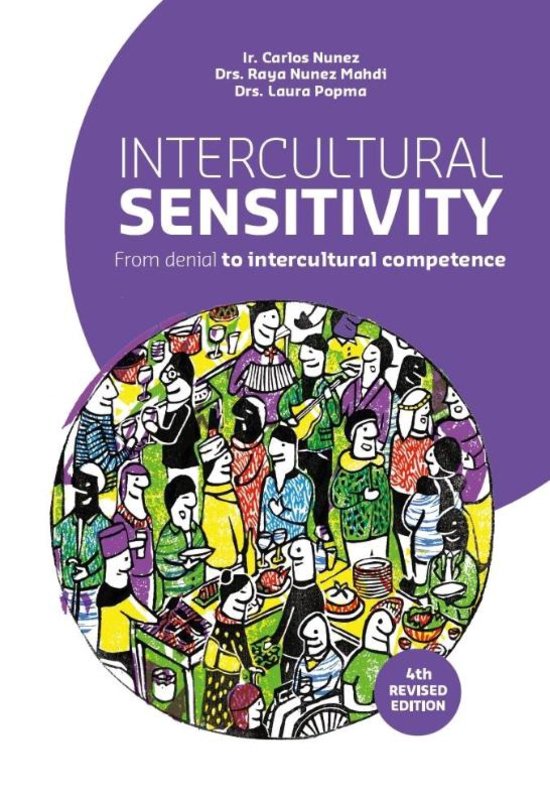Intercultural Sensitivity
,For
Loekie Mahdi-Hardey,
Izak Mahdi,
Maria Teresa Abondano
and Vicente Nunez
,Intercultural Sensitivity
From Denial to Intercultural Competence
Carlos Nunez
Raya Nunez Mahdi
Laura Popma
4th, revised edition
2017
,© 2017, Royal Van Gorcum BV, P.O. Box 43, 9400 AA Assen, The Netherlands.
All rights reserved. No part of this publication may be reproduced, stored in a
retrieval system, or transmitted, in any form or by any means, electronic,
mechanical, photocopying, recording, or otherwise, without the prior permission
of the Publisher.
NUR 812
ISBN folioboek 978 90 232 5555 0
ISBN ebook 978 90 232 5556 7
Cover: Kim Boeren, Viesrood grafisch & interactief ontwerp
Graphic design: Imago Mediabuilders, Amersfoort, The Netherlands
Printing: Royal Van Gorcum, Assen, The Netherlands
Illustrations: Masaaki Oyamada, The Hague, The Netherlands, in cooperation with
Carlos Nunez
, Table of Contents
Preface�������������������������������������������������������������������������������������������������������������������������������������������������������� 9
Chapter 1 Culture, Communication and Global Citizenship�������������� 12
1.1 What is Culture? Visible and Invisible Culture�������������������������������������� 14
1.2 Definition of Culture ��������������������������������������������������������������������������������������������������������������� 15
1.3 Cultural Programming �������������������������������������������������������������������������������������������������������� 16
1.4 Culture and Subcultures���������������������������������������������������������������������������������������������������� 17
1.5 Intercultural Communication�������������������������������������������������������������������������������������� 18
1.6 Noise. What Exactly is Communication Noise?���������������������������������� 19
1.7 TOPOI Model, Intervention for Cultural Noise ���������������������������������� 20
1.8 Global Citizenship �������������������������������������������������������������������������������������������������������������������� 25
1.8.1 Definition������������������������������������������������������������������������������������������������������������������������ 25
1.8.2 Teaching Global Citizenship������������������������������������������������������������������ 26
1.8.3 Global Citizenship Competencies�������������������������������������������������� 28
1.8.4 What does it mean in practice? �������������������������������������������������������� 29
1.9 Assignments ������������������������������������������������������������������������������������������������������������������������������������ 32
Chapter 2 Working with Hall’s Key Concepts of Cultural
Differences�������������������������������������������������������������������������������������������������������������������������������������� 36
2.1 Communication: High and Low Context������������������������������������������������������ 38
2.1.1 Low Context ���������������������������������������������������������������������������������������������������������������� 38
2.1.2 High Context�������������������������������������������������������������������������������������������������������������� 39
2.1.3 Misunderstanding caused by too little or too
much Context������������������������������������������������������������������������������������������������������������� 41
2.1.4 High and Low Context Countries���������������������������������������������������� 42
2.1.5 High and Low Context Subcultures���������������������������������������������� 43
2.1.6 Can we Communicate High as well as Low
Context? Yes���������������������������������������������������������������������������������������������������������������� 43
© Royal Van Gorcum
, Intercultural Sensitivity
2.2 Monochronic and Polychronic Time������������������������������������������������������������������ 46
2.2.1 Monochronic Cultures���������������������������������������������������������������������������������� 47
2.2.2 Polychronic Cultures���������������������������������������������������������������������������������������� 47
2.2.3 How to Succeed by Being both Monochronic and
Polychronic ������������������������������������������������������������������������������������������������������������������ 48
6 2.3 Personal Space������������������������������������������������������������������������������������������������������������������������������ 48
2.3.1 Dealing with Differences in Personal Space���������������������� 49
2.4 Fast and Slow Messages ��������������������������������������������������������������������������������������������������� 51
2.5 Fast and Slow Information Flow������������������������������������������������������������������������������ 54
2.5.1 Slow Information Flow���������������������������������������������������������������������������������� 54
2.5.2 Fast Information Flow������������������������������������������������������������������������������������� 55
2.6 Action Chains���������������������������������������������������������������������������������������������������������������������������������� 56
2.7 Assignments – Cultural Profile according to Hall’s Key
Concepts.���������������������������������������������������������������������������������������������������������������������������������������������� 58
Chapter 3 Working with Kluckhohn’s Variations in Value
Orientations���������������������������������������������������������������������������������������������������������������������������������� 60
3.1 Dominating, in Harmony with or Subjugated to Nature�������� 62
3.2 Past, Present and Future Orientation �������������������������������������������������������������� 64
3.3 Doing or Being Cultures: Task or Relation Orientation ������������ 65
3.4 Individualism and Collectivism�������������������������������������������������������������������������������� 66
3.4.1 Individuals, Collateral Groups and Hierarchical
Groups ������������������������������������������������������������������������������������������������������������������������������ 67
3.4.2 Individualism, Collectivism and David Pinto’s
F- and C-Cultures ������������������������������������������������������������������������������������������������ 69
3.5 Is Space Private or Public?���������������������������������������������������������������������������������������������� 70
3.6 Human Nature������������������������������������������������������������������������������������������������������������������������������ 72
3.7 Pinto’s 3 Step Method��������������������������������������������������������������������������������������������������������� 73
3.8 Assignments ������������������������������������������������������������������������������������������������������������������������������������ 75
Chapter 4 Working with Hofstede’s 6 Dimensions of Culture ������ 78
4.1 Power Distance������������������������������������������������������������������������������������������������������������������������������ 80
4.2 Individualism ���������������������������������������������������������������������������������������������������������������������������������� 82
4.3 Masculinity and Femininity�������������������������������������������������������������������������������������������� 87
4.4 Uncertainty Avoidance �������������������������������������������������������������������������������������������������������� 88
4.5 Long-Term and Short-Term Orientation�������������������������������������������������������� 92
4.5.1 Long-Term Orientation (LTO)�������������������������������������������������������������� 92
4.5.2 Short-Term Orientation�������������������������������������������������������������������������������� 93
4.5.3 A Note on the Long-Term Orientation Scores���������������� 93
4.6 Indulgence and Restraint ������������������������������������������������������������������������������������������������ 94
, Table of Contents
4.7 Country Scores on Hofstede’s Six Dimensions of Culture ���� 95
4.8 Assignments ������������������������������������������������������������������������������������������������������������������������������������ 98
Chapter 5 Cultural Synergy: Trompenaars’ 7 Dimensions and
Cultural Reconciliation �������������������������������������������������������������������������������������������� 100
7
5.1 Universalism – Particularism. Rules or Relationships?�������� 102
5.2 Individualism and Communitarianism������������������������������������������������������ 104
5.3 Emotions: Neutral and Affective ������������������������������������������������������������������������ 104
5.4 Involvement: Specific and Diffuse�������������������������������������������������������������������� 106
5.4.1 What can go wrong when Specific meets
Diffuse? ������������������������������������������������������������������������������������������������������������������������ 108
5.5 Status: Achieved and Ascribed�������������������������������������������������������������������������������� 111
5.6 Time ���������������������������������������������������������������������������������������������������������������������������������������������������������� 115
5.7 Attitudes towards the Environment������������������������������������������������������������������ 115
5.8 Reconciliation: from Vicious Circle to Virtuous Circle������������� 116
5.9 Three steps to Cultural Synergy ��������������������������������������������������������������������������� 121
5.9.1 Cultural Avoidance ����������������������������������������������������������������������������������������� 122
5.9.2 Cultural Dominance ������������������������������������������������������������������������������������� 122
5.9.3 Cultural Accommodation����������������������������������������������������������������������� 122
5.9.4 Cultural Compromise ��������������������������������������������������������������������������������� 123
5.9.5 Cultural Synergy ������������������������������������������������������������������������������������������������� 123
5.10 Assignments ��������������������������������������������������������������������������������������������������������������������������������� 125
Chapter 6 The Growth Process in Intercultural Sensitivity��������������� 128
6.1 Denial ����������������������������������������������������������������������������������������������������������������������������������������������������� 131
6.1.1 Strategies for moving on from the denial stage ������� 131
6.2 Defence������������������������������������������������������������������������������������������������������������������������������������������������� 133
6.2.1 Strategies for moving on from the defence stage��� 133
6.3 Minimization��������������������������������������������������������������������������������������������������������������������������������� 135
6.3.1 Strategies for moving on from the minimization
stage����������������������������������������������������������������������������������������������������������������������������������� 135
6.4 Acceptance��������������������������������������������������������������������������������������������������������������������������������������� 137
6.4.1 Strategies for moving on from the acceptance
stage����������������������������������������������������������������������������������������������������������������������������������� 137
6.5 Adaptation ��������������������������������������������������������������������������������������������������������������������������������������� 139
6.5.1 Strategies for developing even further when you
are in adaptation ����������������������������������������������������������������������������������������������� 139
6.6 Integration/Intercultural Competence��������������������������������������������������������� 141
6.7 Assignment: Intercultural Sensitivity Role Play ������������������������������ 142
© Royal Van Gorcum
, Intercultural Sensitivity
Chapter 7 Culture Shock While Studying Abroad�������������������������������������������� 144
7.1 Culture Shock. What is it?�������������������������������������������������������������������������������������������� 146
7.2 What are the Stages of Culture Shock?������������������������������������������������������� 146
7.3 Pre-Departure Stage������������������������������������������������������������������������������������������������������������ 148
8 7.4 The Vacation Stage ��������������������������������������������������������������������������������������������������������������� 149
7.5 The Angry Stage������������������������������������������������������������������������������������������������������������������������� 150
7.6 Adjustment Stage and Strategies����������������������������������������������������������������������� 151
7.7 Re-entry Shock����������������������������������������������������������������������������������������������������������������������������� 151
7.8 Re-entry Shock and International Careers����������������������������������������������� 153
7.9 Assignments ��������������������������������������������������������������������������������������������������������������������������������� 155
Chapter 8 Multicultural Teams and Global Leadership��������������������������� 156
8.1 Managing Diversity in Teams����������������������������������������������������������������������������������� 158
8.2 Multicultural Teams’ Strengths, Weaknesses and
Conditions for Excellence �������������������������������������������������������������������������������������������� 160
8.2.1 What are the Strengths of Multicultural Groups?��� 160
8.2.2 Weaknesses in Multicultural Teams����������������������������������������� 162
8.2.3 What are the conditions for multicultural team
effectiveness?��������������������������������������������������������������������������������������������������������� 162
8.3 Multicultural Teams during the Stages of Group
Formation ����������������������������������������������������������������������������������������������������������������������������������������� 162
8.4 Global Leadership: the GLOBE Project������������������������������������������������������� 164
8.5 GLOBE Dimensions or Cultural Competencies������������������������������� 165
8.5.1 As it is and how it should be ������������������������������������������������������������� 167
8.6 GLOBE Leadership Clusters ������������������������������������������������������������������������������������� 167
8.7 GLOBE Leadership and Values ����������������������������������������������������������������������������� 169
8.8 Assignments ��������������������������������������������������������������������������������������������������������������������������������� 171
About the Authors ����������������������������������������������������������������������������������������������������������� 176
About the Illustrator ����������������������������������������������������������������������������������������������������� 178
Bibliography������������������������������������������������������������������������������������������������������������������������������� 179
,
Preface
This book is a first approach of what can happen at the university or business
schools where students of all nationalities and cultures come together.
You are going to read an enlightening testimony on what could happen to you
students when working later in companies, without being aware of the content of
this book.
The authors most warmly thank Mr Luis Miguel Rojo Y Pinto for sharing his field
experience with the students.
“With both parents from Spanish origin, I was born in France and considered myself as
being a pure multicultural product, till I had to settle in Latin America a few years ago.
That’s where I got my first real “intercultural slap” while having a meeting with
Columbian engineers. As we were looking into security issues for our vehicles, my purpose
had been to concentrate on the necessity to fit them out with series airbags and ABS. One
of them just replied that security was essentially linked to the engine power, which was
vital to overtake on the overcrowded roads of this magnificent country.
This anecdote cruelly brought me back to the notion of context.
Another example: when a Marketing team in Venezuela presented me with a very
interesting project, I let out a vibrating “Not bad!” which made the Project Manager
immediately turn pale and asked me why I didn’t like that project. This was all a question
of interpretation, “Not bad” in Venezuela is a polite way to say you refuse the project.
Consequently, when working for a Korean brand, I had to change the way I defended and
presented the projects to the Korean executives, presuming that it was impossible for them
to lose face opposite their counterparts with the same power distance, even if I had
previously succeeded in obtaining their agreement. All a question of culture.
I am now working with Nissan, in a Regional Business Unit, bringing together France, the
Netherlands and Belgium. It is a daily concern to me as I am confronted to the difficulty
© Royal Van Gorcum
, Intercultural Sensitivity
to adapt communication patterns in order to align multicultural teams and meet shared
goals. Strange as it may seem, a French “yes” is not necessarily interpreted in the same way
as a Dutch “yes”. There is no such thing as a universal way of applying the filters we get
from our upbringing, our social environment or our experience. Even if we are used to
global environments and we have the feeling that we do know “the world” through all kinds
10 of media and tools at our disposal, we are not always aware of the need for decoding the
messages. In that case, we have to use our counterparts’ references and not ours.
This book is based on real examples and exercises and enables the reader to, not only
understand why the exchange of messages that seem clear are not understood, but also to
ponder on questions about his own story. In each chapter you will find basic principles
which throw a light on the differences in interpretation between cultures. Take some time
and hindsight to consider those aspects and you will most probably avoid blunders that
can sometimes cause violent shocks. Those are more often related to the use of an
inadequate form rather than to a disagreement on the content.”
Luis Miguel Rojo Y Pinto, Marketing General Manager, Nissan West Europe






